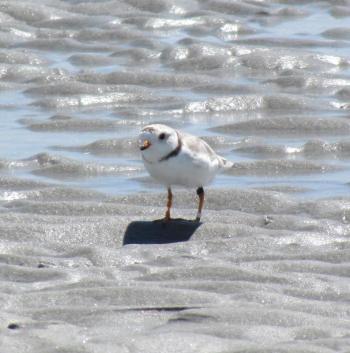A Day at the Beach for Plovers and Terns
The weekend before July 4th we had the pleasure of visiting a natural area beloved by many here in Maine: Reid State Park. We walked along the half mile beach portion, letting the occasional gentle wave cool our feet with the 52 degree water. A third of the way down the beach and up toward the dunes, we could see some signs and simple stake-and-twine fencing surrounding a small patch. These were the familiar indications of an area protected for the use of some special beach nesting birds, least terns and piping plovers. Unfortunately it appeared as if neither species was using that particular area this year, at least not at this time, but it was heartening to see that the birds had someone watching out for them.
Least terns and piping plovers are highly specialized species that nest almost exclusively on sandy beaches. Least terns reach their northern Atlantic Coast range limit in Maine but nest on beaches south from here along the entire Atlantic and Gulf coasts in to Mexico and through the Caribbean south to Aruba, Bonaire and Curacao; on sandy bars along parts of the broad Mississippi drainage north to eastern Montana, and on the Pacific Coast from central California south to Panama. Here in Maine, least terns’ northernmost nesting location has been at Reid State Park although they have not nested there since 2006 so the northernmost nesting site has been claimed by Popham Beach since then. The numbers in Maine have varied greatly from year to year but there were an estimated 233 pairs in 2015, almost all at just three locations south of Portland.
Piping plovers have greatly increased across much of their range as a result of concerted efforts of the U.S. Fish and Wildlife Service (USFWS) and thousands of partner organizations. Along the Atlantic Coast the total number of piping plovers more than doubled between 1986 and 2008. Here in Maine numbers were at a low of only six pairs in 1983 but on-the-ground protection efforts (including sometimes placing heavy duty fencing around nesting birds) by USFWS, Maine Audubon, Maine Inland Fisheries and Wildlife, and others has brought the population up so that in 2015 there were an estimated 62 pairs. A few years ago we had the distinct pleasure of watching a flock of 19 piping plovers feeding together in late summer at Goose Rocks Beach in Kennebunkport. That was a sight that we would never have imagined seeing in Maine!
Both least terns and piping plovers place their eggs in a slight depression in the sand and rely on their coloration to make it hard for predators to spot them. Least terns try to add in extra protection by nesting in colonies and swooping down on any animal that they perceive as a potential threat to their eggs or young. They will even sometimes try to strike the intruder with the bill, and they are more than willing to drop smelly white “guano bombs.” We know from experience that they can aim those guano bombs with amazing accuracy at times! Piping plovers, on the other hand, are territorial and space out their nests away from each other. They tend to nest farther into the dune vegetation than do least terns. When on the nest, they can be almost impossible to see.
Unusually high tides and storm waves as well as heavy rain events can wash away nests of either species but the factors most likely to cause reproductive failure are predators and disturbance. Predators can range from natural, native species like foxes, raccoons, and crows but sadly can also be roaming neighborhood house cats and unleashed dogs. Humans can unknowingly step on eggs or cause adult birds to abandon nests or young; on a hot beach, that can be a lethal for eggs or chicks. The fencing around tern and plover nests is there for a reason! People need to keep their distance from such areas.
The increase of personal fireworks that are exploded on or near beaches at night is also detrimental for beach nesting birds like least terns and piping plovers. Most people know how disturbed pets often are by the sounds and sights of fireworks. Imagine what it’s like for native birds and other animals.
During the Independence holiday time, we look back with thankfulness for the great work that so many patriotic people have done to ensure that we still have birds like piping plovers and least terns that represent a significant part of our natural heritage. Let’s also do all we can to ensure that these birds have a healthy and prosperous nesting season.
Jeffrey V. Wells, Ph.D., is a Fellow of the Cornell Lab of Ornithology. Dr. Wells is one of the nation's leading bird experts and conservation biologists, and author of “Birder’s Conservation Handbook.” His grandfather, the late John Chase, was a columnist for the Boothbay Register for many years. Allison Childs Wells, formerly of the Cornell Lab of Ornithology, is a senior director at the Natural Resources Council of Maine, a statewide nonprofit membership organization working to protect the nature of Maine. Both are widely published natural history writers and coauthors of the book, “Maine’s Favorite Birds.”
































.png)
.png)
